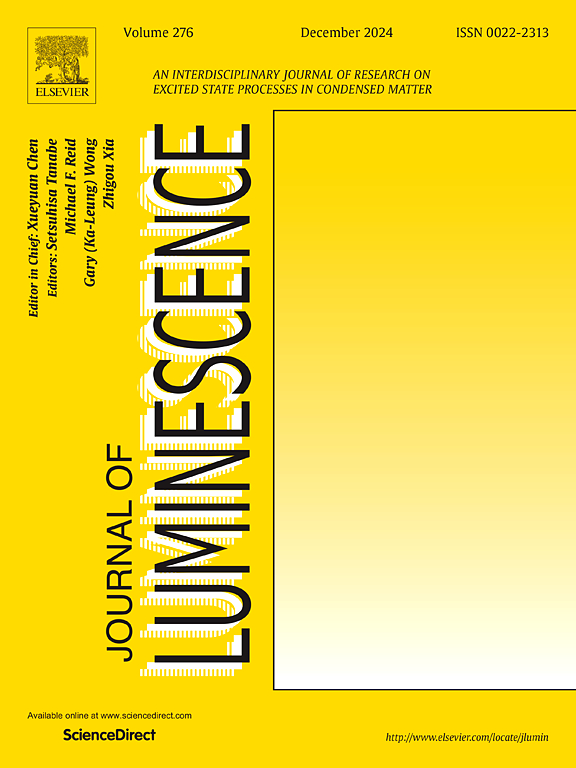紫外 LED 泵浦的 Er3+ 掺杂 YOF 陶瓷粉末:基于绿色荧光的光学温度测量法
IF 3.3
3区 物理与天体物理
Q2 OPTICS
引用次数: 0
摘要
稀土基荧光粉材料已被研究用于光子学应用,如放大、照明和传感。其中,铒(Er3+)掺杂的氧化氟化钇(YOF)特别有趣,因为它结合了Er3+覆盖紫外-可见-红外光谱区域的大量发射线,以及YOF材料强大的化学和机械性能。本文采用燃烧反应法制备了掺杂Er3+的YOF陶瓷粉末,并对其结构和光学性质进行了研究,用于光学测温。利用365 nm波长的紫外LED激发了光子下转换(DC)机制。采用荧光强度比(FIR)法研究了Er3+在空气和水中4f-4f跃迁2H11/2→4I15/2和4S3/2→4I15/2对应的直流光谱的温度变化。实验在283 ~ 343 K的温度范围内进行,发现在343 K时绝对灵敏度最高为0.24% K−1,在283 K时相对灵敏度最高为1.92% K−1。当FIR方法探索从(2h11 / 2,4s3 /2)→4I15/2转变的热耦合Stark组分时,获得了最高的温度灵敏度。本文章由计算机程序翻译,如有差异,请以英文原文为准。

UV LED-pumped Er3+-doped YOF ceramic powder: Optical thermometry based on the green fluorescence
Rare-earth based phosphor materials have been studied for photonics applications such as amplification, lighting, and sensing. Among others, erbium (Er3+) doped yttrium oxyfluoride (YOF) is particularly interesting because it combines the multitude of emission lines from Er3+ covering the UV–Vis-IR spectral region with the robust chemical and mechanical properties of YOF material. In this work, Er3+-doped YOF ceramic powders were synthesized via a combustion reaction method and their structural and optical properties were investigated for optical thermometry. Photon down-conversion (DC) mechanism was stimulated by a UV LED emitting at 365 nm. The temperature changes of the DC spectrum in the green region, which corresponds to 4f-4f transitions 2H11/2 → 4I15/2 and 4S3/2 → 4I15/2 of Er3+, were investigated using the fluorescence intensity ratio (FIR) approach in air and in water. The experiments were performed in the temperature range of 283–343 K with the highest absolute sensitivity value of 0.24 % K−1 at 343 K and the highest relative sensitivity value of 1.92 % K−1 at 283 K being found. The highest temperature sensitivities were obtained when the FIR approach explored the thermally coupled Stark components from (2H11/2,4S3/2) → 4I15/2 transitions.
求助全文
通过发布文献求助,成功后即可免费获取论文全文。
去求助
来源期刊

Journal of Luminescence
物理-光学
CiteScore
6.70
自引率
13.90%
发文量
850
审稿时长
3.8 months
期刊介绍:
The purpose of the Journal of Luminescence is to provide a means of communication between scientists in different disciplines who share a common interest in the electronic excited states of molecular, ionic and covalent systems, whether crystalline, amorphous, or liquid.
We invite original papers and reviews on such subjects as: exciton and polariton dynamics, dynamics of localized excited states, energy and charge transport in ordered and disordered systems, radiative and non-radiative recombination, relaxation processes, vibronic interactions in electronic excited states, photochemistry in condensed systems, excited state resonance, double resonance, spin dynamics, selective excitation spectroscopy, hole burning, coherent processes in excited states, (e.g. coherent optical transients, photon echoes, transient gratings), multiphoton processes, optical bistability, photochromism, and new techniques for the study of excited states. This list is not intended to be exhaustive. Papers in the traditional areas of optical spectroscopy (absorption, MCD, luminescence, Raman scattering) are welcome. Papers on applications (phosphors, scintillators, electro- and cathodo-luminescence, radiography, bioimaging, solar energy, energy conversion, etc.) are also welcome if they present results of scientific, rather than only technological interest. However, papers containing purely theoretical results, not related to phenomena in the excited states, as well as papers using luminescence spectroscopy to perform routine analytical chemistry or biochemistry procedures, are outside the scope of the journal. Some exceptions will be possible at the discretion of the editors.
 求助内容:
求助内容: 应助结果提醒方式:
应助结果提醒方式:


